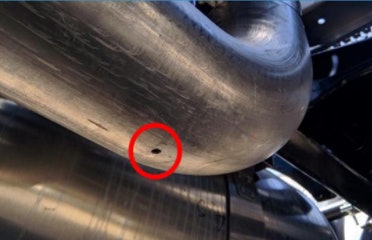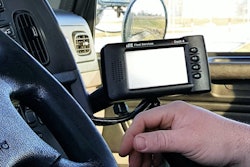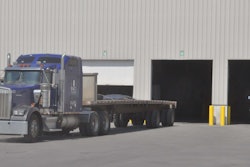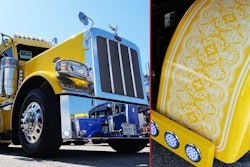 The state of Kentucky (its Franklin County scale house shown here) was one of several states involved in a variety of field tests of different aspects of so-called “electronic inspections,” now with some official recognition and definition.
The state of Kentucky (its Franklin County scale house shown here) was one of several states involved in a variety of field tests of different aspects of so-called “electronic inspections,” now with some official recognition and definition.A new Level 8 electronic inspection, in development for the last couple years via the Commercial Vehicle Safety Alliance of trucking industry and enforcement personnel, is now part of a new operational policy from the agency. The move amounts to recognition of the existing definition for what such an inspection needs to include when North American “jurisdictions get the ability to do an electronic inspection,” said Kerri Wirachowsky, CVSA’s director for its roadside inspection program. None that she knows of, she adds, have such ability today.
The update sets the stage for further tests of the concept to come in a variety of jurisdictions. Officials in the Canadian province of Alberta recently signaled their willingness to move forward with it following CVSA’s Board of Directors voting to include recognition of the Level 8 inspection as a policy. The designation also follows a variety of e-inspection/expedited Level 3 demonstrations that have occurred around the United States the last several years, spearheaded by state jurisdictions, the Drivewyze company, and a variety of other technology providers. The Federal Motor Carrier Safety Administration, too, has long pursued proof of concept demonstrations of its Wireless Roadside Inspection effort, in recent years hampered to a certain extent by Congressional efforts to limit funding for the project amid concerns over its perceived conflict with inspection technology available today.
While the federal effort envisions wireless inspection at levels beyond just driver/carrier credentialing, the new Level 8 inspection definition hews closers to the “expedited Level 3” demonstrated by private groups and states. The Level 8 is defined as an “inspection conducted electronically or wirelessly while the vehicle is in motion without direct interaction with an enforcement officer,” moving beyond those expedited Level 3 tests, which Overdrive covered last year. Those, of course, still required the interaction of driver and officer to finish the inspection.
An electronic inspection, according to the CVSA definition, must include the following data points:
- A “descriptive location, including GPS coordinates.”
- Electronic validation of the current operator, including “driver’s license class” and any endorsements, a “valid Medical Examiner’s Certificate” and, where applicable, a Skill Performance Evaluation (SPE) Certificate for those with medical waivers for missing limbs.
- Current hours of service status and compliance information.
- The USDOT or (Canada) NSC number of the authorized carrier, power unit registration information, operating authority info, and Unified Carrier Registration (UCR) compliance information.
- Finally, any federal out-of-service orders.
CVSA Director Wirachowsky was speaking as part of a May 31 webinar devoted to updating CVSA membership on changes to a variety of policies, inspection bulletins and procedures that came most out of the most recent, April CVSA Workshop event in Atlanta. Other policy updates of note included recognition of push-to-connect fittings within the air brake system as proper connections, among others.
A variety of publicly accessible inspection bulletins, too, were newly issued or updated, all the result of committee work at the Workshop that “then went through board of directors” for approval, Wirachowsky said.
The 2010-02 bulletin related to the inspection of 2007 and later trucks, many with engines with diesel-particulate-filter and selective catalytic reduction aftertreatment systems was updated to recognize the existence of drain holes in the exhaust system in places other than factory mufflers.
 This image showing an exhaust-elbow intentional drain hole was added to the inspection bulletin to illustrate the variety of hole locations, which shouldn’t be marked as violations. “The previous version had a photo of an intentional drain hole in the muffler,” Wirachowsky said, “but newer models have water drain holes in other places.”
This image showing an exhaust-elbow intentional drain hole was added to the inspection bulletin to illustrate the variety of hole locations, which shouldn’t be marked as violations. “The previous version had a photo of an intentional drain hole in the muffler,” Wirachowsky said, “but newer models have water drain holes in other places.”The 2013-02 bulletin on ABS inspections was clarified to resolve issues with procedures for testing indicator lamps’ functionality and other faults in the systems. For driver utilizing the bulletin, the flowcharts for inspection procedures within the bulletin were updated to reflect the necessity of a second individual to be involved in the process to check the indicator lamps’ cycling functionality.
The 2014-02 bulletin dealing with the identification of long-stroke brake chambers was updated to recognize the addition of a new SAE standard for markings on chambers to indicate stroke. Though Wirachowsky noted the new SAE J2899 standard is not yet in use by manufacturers, it specifies stroke marking A through H to indicate rated stroke in markings “three times the size” of all others.
A new bulletin 2017-02 deals with securement issues related to intermodal containers on chassis, a total rewrite of an older bulletin.











